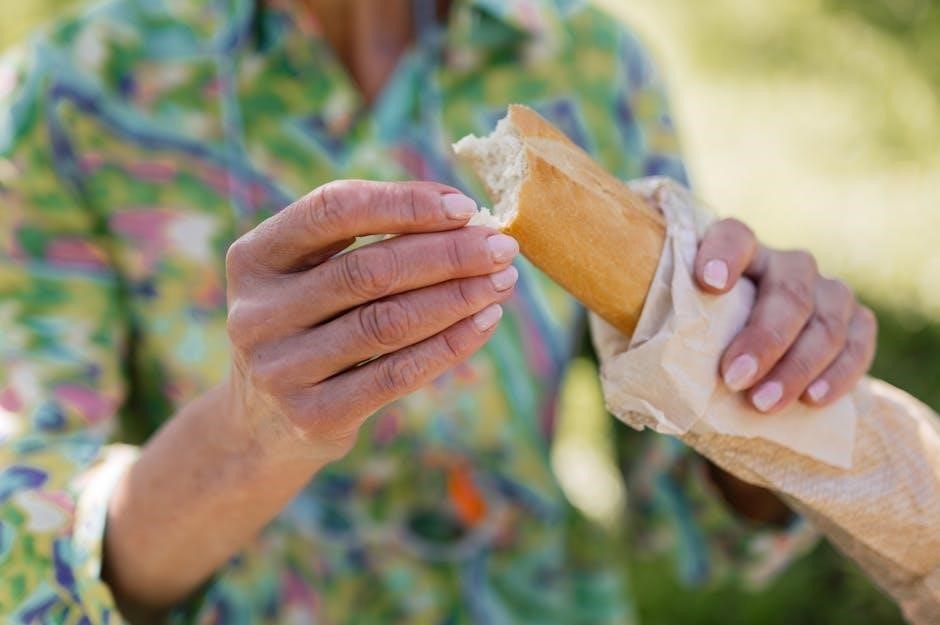Take and Bake Baguette Instructions: A Comprehensive Guide
Baking a take and bake baguette is a simple way to enjoy fresh bread at home; This guide provides comprehensive instructions, from preheating the oven to serving the perfectly baked baguette. Follow these steps for a delicious, bakery-quality experience.
Understanding Take and Bake Baguettes

Take and bake baguettes offer a convenient way to enjoy freshly baked bread without the time and effort of making it from scratch. These baguettes are partially baked, allowing you to finish the baking process in your own oven. This ensures a warm, crusty loaf whenever you desire. Understanding the nature of these baguettes is key to achieving optimal results.
The beauty of take and bake baguettes lies in their simplicity. They are designed to be user-friendly, requiring minimal preparation and baking time. Whether you’re a seasoned baker or a novice in the kitchen, you can easily transform a take and bake baguette into a delicious centerpiece for any meal.
The quality of a take and bake baguette depends on various factors, including the ingredients, the initial baking process, and your final baking touch. By following the instructions carefully and paying attention to detail, you can consistently produce a baguette that rivals those from your favorite bakery. This guide will walk you through each step, ensuring a perfect bake every time.

Initial Preparation: Preheating the Oven
Preheating the oven is a crucial first step in baking a take and bake baguette. An adequately preheated oven ensures that the baguette bakes evenly and develops a crisp, golden-brown crust. This initial preparation sets the stage for a successful baking process and a delicious final product.
Before you even unwrap the baguette, turn on your oven and set it to the recommended temperature. This allows the oven to reach the desired heat level, ensuring consistent baking. Using an oven thermometer can help verify that the oven has reached the correct temperature.
The preheating time may vary depending on your oven model. Generally, it takes about 15-20 minutes for an oven to preheat fully. Be patient and wait until the oven signals that it has reached the set temperature before placing the baguette inside. Rushing this step can lead to uneven baking and a less-than-perfect crust. A properly preheated oven is the foundation for a perfectly baked take and bake baguette.
Recommended Oven Temperature
The recommended oven temperature is crucial for achieving the perfect take and bake baguette. Setting the temperature correctly ensures that the baguette bakes evenly, developing a crisp crust and a soft, airy interior. Different brands and types of baguettes may require slightly different temperatures, so it’s essential to consult the packaging instructions.
Typically, a temperature range of 375°F to 400°F (190°C to 200°C) works well for most take and bake baguettes. Some instructions may suggest a specific temperature like 385°F (196°C), which is a common recommendation for Kroger take and bake French baguettes. Always prioritize the instructions provided on the packaging, as they are tailored to the specific product.
Using an oven thermometer can help you verify that your oven is accurately reaching and maintaining the set temperature. This is especially important if your oven tends to run hot or cold. A consistent oven temperature is key to baking a take and bake baguette to perfection, resulting in a delicious and satisfying loaf every time.
Baking Time: Fresh vs. Frozen
Baking time for take and bake baguettes varies significantly depending on whether the baguette is fresh or frozen. Fresh baguettes, typically those stored at room temperature or in the refrigerator, require a shorter baking time compared to those baked directly from a frozen state.
For fresh baguettes, the baking time usually ranges from 5 to 15 minutes, depending on the size and thickness of the baguette and the oven temperature. It’s crucial to monitor the baguette closely to prevent over-baking, which can result in a dry and hard crust. Look for a golden-brown color and a hollow sound when tapped on the bottom.
Frozen baguettes, on the other hand, require a longer baking time to ensure they are thoroughly heated and baked through. The baking time for frozen baguettes typically ranges from 10 to 25 minutes. Again, it’s essential to follow the specific instructions on the packaging, as baking times can vary. Adding a few extra minutes to the baking time may be necessary to achieve the desired golden-brown crust and warm, soft interior.
Baking Time for Thawed Baguettes
When baking a take and bake baguette that has been previously frozen and then thawed, the baking time differs from both fresh and directly-from-frozen scenarios. Thawing allows the dough to warm up, reducing the time needed in the oven.
Typically, a thawed baguette will require a baking time of around 8 to 15 minutes, depending on its size and the oven’s efficiency. The key is to achieve a golden-brown crust without drying out the interior. Keep a close watch and start checking for doneness around the 8-minute mark.
To ensure even baking, place the baguette on the center rack of your preheated oven. A good indicator of doneness is when the crust turns a desirable golden color and the baguette sounds hollow when tapped gently on the bottom. Remember, every oven varies, so these times are approximate. Always refer to the specific instructions on the baguette packaging for the most accurate guidance. Enjoy your freshly baked, thawed baguette!
Placement in the Oven
Proper placement within the oven is crucial for achieving a perfectly baked take and bake baguette. The ideal position ensures even heat distribution, leading to a uniformly golden crust and a thoroughly cooked interior. Generally, the center rack is the most recommended spot. This location provides balanced exposure to both the top and bottom heating elements.
If your oven tends to heat unevenly, rotating the baguette halfway through the baking time can help compensate for any hot spots. For ovens with a convection setting, using this option can also promote more consistent baking by circulating hot air around the baguette.
Avoid placing the baguette too close to the top or bottom heating elements, as this can result in burning or undercooking. Always ensure the baguette has enough space around it for proper air circulation. By paying attention to placement, you’ll significantly improve the quality and appearance of your baked baguette. Remember to consult your oven’s manual for specific recommendations.
Monitoring the Baking Process
Carefully monitoring the baking process is essential to achieve a perfectly baked take and bake baguette. Start by setting a timer for the recommended baking time, but rely more on visual cues and the baguette’s texture. Regularly check the baguette’s color, looking for a gradual transition to a golden-brown hue. This indicates that the crust is developing properly.
Keep an eye out for any signs of burning, especially on the top surface. If the baguette seems to be browning too quickly, you can gently tent it with aluminum foil to slow down the process. Also, listen for subtle sounds, such as a slight crackling, which can indicate the baguette is nearing completion.
Avoid opening the oven door frequently, as this can cause temperature fluctuations and affect the baking. Instead, use the oven light to observe the baguette’s progress. Remember, patience and attention to detail are key. Consistent monitoring will help you determine when the baguette has reached the ideal level of doneness.
Achieving a Golden Brown Crust
Achieving a golden-brown crust on your take and bake baguette is crucial for both its appearance and flavor. Several factors contribute to this desirable outcome. Firstly, ensure that your oven is preheated to the correct temperature, as this provides the initial heat necessary for crust formation.
Secondly, consider the placement of the baguette in the oven. Placing it in the center rack allows for even heat distribution, promoting uniform browning. If your oven tends to heat unevenly, rotating the baguette halfway through the baking process can help.
Thirdly, monitor the baguette closely during the final minutes of baking. The crust can quickly transition from golden brown to burnt, so vigilance is key. If needed, you can slightly increase the oven temperature during the last few minutes to enhance browning, but do so cautiously to avoid burning. Finally, proper cooling after baking can further enhance the crust’s texture.
Checking for Doneness: The Hollow Sound Test
One of the most reliable methods for determining if your take and bake baguette is fully baked is the hollow sound test. This technique involves gently tapping the bottom of the baguette and listening to the sound it produces. A properly baked baguette will emit a hollow sound, indicating that the interior is cooked through and the crust has solidified.
To perform the test, carefully remove the baguette from the oven and use tongs or a gloved hand to tap the bottom crust. If the sound is dull or muffled, it suggests that the interior is still doughy and requires additional baking time. Continue baking in short increments, such as 2-3 minutes, and repeat the hollow sound test until the desired resonance is achieved.
Be cautious not to overbake the baguette, as this can result in a dry and hard texture. The hollow sound test, combined with visual cues like a golden-brown crust, will help you determine the perfect moment to remove your baguette from the oven.
Cooling the Baguette
Once the take and bake baguette has reached the desired level of doneness, it’s time to cool it properly. Cooling is a crucial step in the baking process, as it allows the internal structure of the baguette to set, preventing it from becoming soggy or losing its crispness.
To cool the baguette, transfer it from the baking sheet to a wire rack. This allows air to circulate around the entire baguette, promoting even cooling. Avoid placing the baguette on a solid surface, as this can trap moisture and lead to a soft crust.
Allow the baguette to cool completely before slicing and serving. While it may be tempting to cut into the warm bread immediately, resist the urge! The cooling process can take anywhere from 30 minutes to an hour, depending on the size and thickness of the baguette; During this time, the internal moisture will redistribute, resulting in a more flavorful and texturally pleasing final product.
Toaster Oven Instructions
Baking a take and bake baguette in a toaster oven can be a convenient option, especially for smaller portions or when you don’t want to heat up your entire oven. However, due to the smaller size and different heating characteristics of toaster ovens, some adjustments to the standard baking instructions may be necessary.
First, preheat your toaster oven to the temperature recommended on the baguette packaging. Keep a close eye on the baguette during baking, as toaster ovens can sometimes heat unevenly or more intensely than conventional ovens. Reduce the baking time by a few minutes to prevent burning.

Place the baguette directly on the toaster oven rack or on a baking sheet lined with parchment paper. If the baguette is too long to fit comfortably, you may need to cut it in half or bake it in shorter segments. Rotate the baguette halfway through the baking process to ensure even browning. The baguette is done when it’s golden brown and sounds hollow when tapped.
Serving Suggestions
A freshly baked baguette offers endless possibilities for serving and enjoying. Its crusty exterior and soft interior make it a versatile accompaniment to various meals and snacks. For a simple yet satisfying appetizer, slice the baguette and serve it with a selection of cheeses, such as brie, goat cheese, or sharp cheddar. Add some olives, grapes, and nuts for a complete cheese board experience.

Baguette slices are also perfect for making crostini. Brush the slices with olive oil, toast them in the oven, and top them with various ingredients like chopped tomatoes, basil, garlic, or a drizzle of balsamic glaze. For a heartier meal, use the baguette to make sandwiches. Classic fillings like ham and cheese, turkey and avocado, or roast beef and horseradish are always a hit.
Serve alongside soups, stews, or salads, perfect for dipping into sauces. For a sweet treat, create French toast.
Storage Tips
Proper storage is essential to maintain the freshness and quality of your take and bake baguette. If you plan to bake the baguette within a day or two of purchase, storing it at room temperature is acceptable. Keep it in its original packaging or a breathable paper bag to prevent it from drying out too quickly. Avoid storing it in a plastic bag, as this can trap moisture and make the crust soggy.
For longer storage, freezing is the best option. Wrap the unbaked baguette tightly in plastic wrap, then place it in a freezer bag. This will protect it from freezer burn and help it retain its flavor and texture. When ready to bake, you can bake it from frozen, adding a few extra minutes to the baking time. Alternatively, thaw it in the refrigerator overnight before baking for optimal results.
Once baked, store leftover baguette slices in an airtight container at room temperature. To revive a slightly stale baguette, lightly mist it with water and warm it in the oven for a few minutes.
